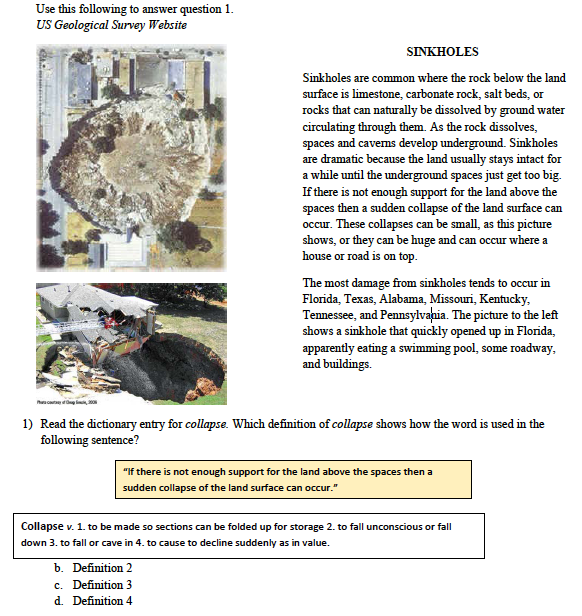Describing Images for Enhanced Assessments
Photos and Drawings
Many items contain photos and drawings. How these images are described depends on their context within the item. The four examples provided below include images of different sizes and purposes. Some images are required to answer the question, others are not. As with all image description, these descriptions should be brief and clear.

Top of Page

Since there is a lot of text in this poster, all of which needs to me made accessible, the images of the quarters in the trees are superfluous and a description would unnecessarily lengthen the amount of time it would take a student to read the item and answer the question. If deemed a necessity, an image description could read: "A drawing of quarters and leafy trees."
Why?
Top of Page

While the photos are visually interesting and contain visual detail, it might seem necessary to provide a few sentences of description. However, since article provides additional description of the images, and, given the low importance of the images to answering the question, a lengthy description might, upon first reading, imply that the photos were vital, and thus increasing the cognitive load for the student who is being tested on their reading comprehension. Note: in addition to the brief image descriptions, all of the text must be made accessible.
Top of Page

Like the others, these images should receive brief descriptions. It might be tempting to describe the first image as: "Photo of Goblin Valley State Park." However, the image immediately provides additional information about the park to the sighted reader, which should be considered, most importantly that it is in the desert. Also, we chose to provide one sentence of detail in the map description. In the assessment the map image was a bit larger than it is here and the details were more clear.
Note: in addition to the brief image descriptions, all of the text must be made accessible.
A map shows Goblin Valley in Utah. Goblin Valley is west of route 24 and south of I-70 and Green River.
Top of Page
Return to List of Examples
Funding for this project is from the U.S. Department of Education to the Utah State Office of Education under Grant Award #S368A090019. Any opinions, findings, and conclusions or recommendations are those of the project team and do not necessarily reflect those of the U.S. Department of Education.
Simple Drawing

How To Describe This Image:
For the adult (and some students,) the drawing is unnecessary to answering the question. Answer choice "d" is the only one that includes two living things. So, while the picture does requires a description as part of the item, the description should be very brief.Description:
A drawing shows trees, a flying bird, a pond, a cloud in the sky, a rabbit and a rock.Top of Page
Poster

How To Describe This Image:
The question for this item asks: "Who is the audience for this poster?"Since there is a lot of text in this poster, all of which needs to me made accessible, the images of the quarters in the trees are superfluous and a description would unnecessarily lengthen the amount of time it would take a student to read the item and answer the question. If deemed a necessity, an image description could read: "A drawing of quarters and leafy trees."
Description:
A poster reads: Donate Your Quarters! Support Valley View Elementary School's "Buy and Plant" Tree Project!Why?
- Trees will make our playground beautiful!
- Trees provide oxygen for us to breath!
- Trees create shady places for us to relax!
- Trees are good for the environment!
Top of Page
Article

How To Describe This Image:
In this reading comprehension item, the question asks for the definition of a word used in the article. Clearly, the photos aren't vital to answering the question. However, they should receive some description since they are referred to (and, in fact, described) in the article itself.While the photos are visually interesting and contain visual detail, it might seem necessary to provide a few sentences of description. However, since article provides additional description of the images, and, given the low importance of the images to answering the question, a lengthy description might, upon first reading, imply that the photos were vital, and thus increasing the cognitive load for the student who is being tested on their reading comprehension. Note: in addition to the brief image descriptions, all of the text must be made accessible.
Description:
Photos of sinkholes.Top of Page
Website

How To Describe This Image:
Similar to the previous two examples, the images included in the website are largely decorative and not necessary to answer the question (which asks about rental dates.)Like the others, these images should receive brief descriptions. It might be tempting to describe the first image as: "Photo of Goblin Valley State Park." However, the image immediately provides additional information about the park to the sighted reader, which should be considered, most importantly that it is in the desert. Also, we chose to provide one sentence of detail in the map description. In the assessment the map image was a bit larger than it is here and the details were more clear.
Note: in addition to the brief image descriptions, all of the text must be made accessible.
Description:
A photo shows desert cliffs and rock formations.A map shows Goblin Valley in Utah. Goblin Valley is west of route 24 and south of I-70 and Green River.
Top of Page
Return to List of Examples
Funding for this project is from the U.S. Department of Education to the Utah State Office of Education under Grant Award #S368A090019. Any opinions, findings, and conclusions or recommendations are those of the project team and do not necessarily reflect those of the U.S. Department of Education.
